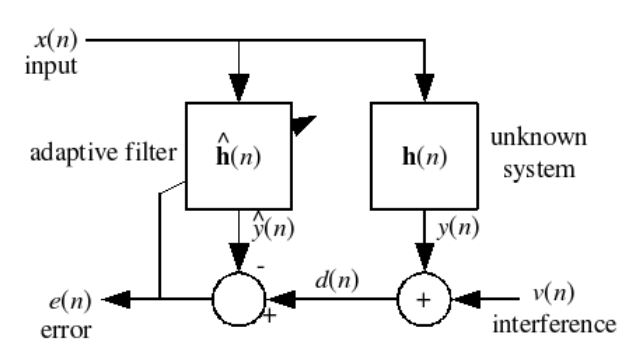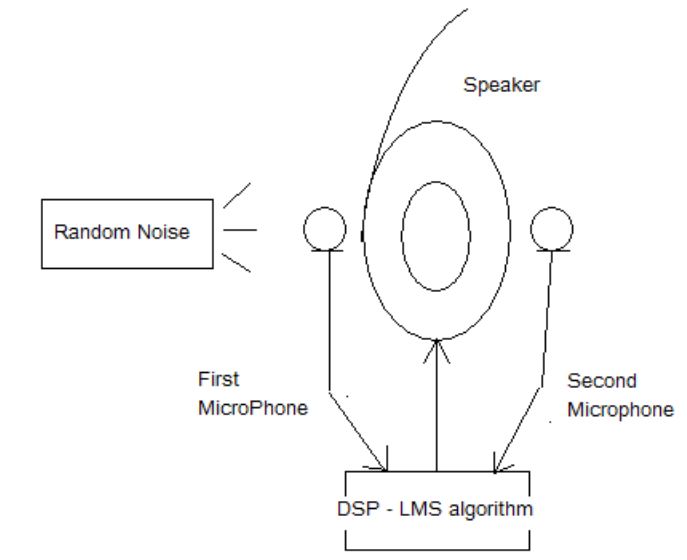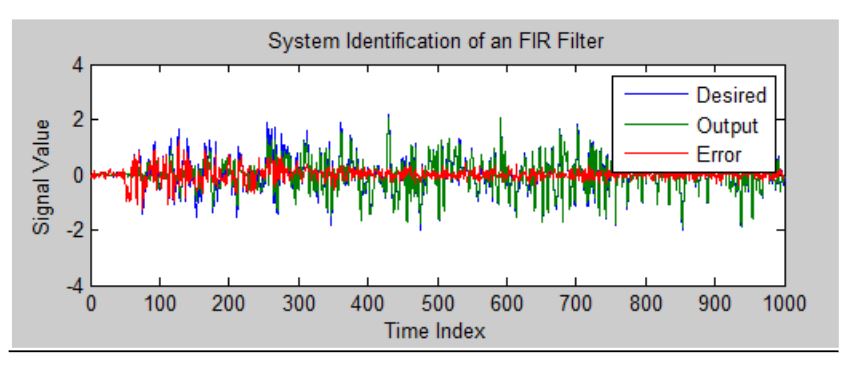ABSTRACT
In this project, I tried to build a noise-cancellation system using DSK. Two microphones and one speaker were used in the system: the first microphone is to sample unexpected noises from the outside and the second microphone is to collect all the sounds, including both the desire sounds and unexpected noises. The second microphone detects and evaluates how well the noise cancellation works.
I used Least Mean Square algorithm to implement Noise Cancellation system. The output of the adaptive filters in LMS algorithm would be phase shifted by 180 degrees and sent to a speaker to generate the anti-noise sound, which would cancel noises.
BACKGROUND

Figure 2: A block diagram of the whole system

Figure 3: A block diagram of an adaptive filter part in LMS algorithm
Usually, noises are random and have some characteristics of amplitude, phase, and speed of sound. To control this random noise well, the active noise control system should be used. Adaptive filter algorithm adjusts its internal filter coefficients to minimize error signals between unknown system and adaptive filter. The least-mean-squares algorithm is one of adaptive filters algorithm; the LMS algorithm and its relatives are all adaptive filtering algorithms. The basic block diagram is shown in Figure 2 and Figure 3.
REQUIREMENTS
The general requirement for this project is to cancel out noise from a speaker. If a speaker is not made from some good materials to cover ears perfectly, then noises disturb users to listen to only what they want; which way is known as a passive noise cancellation. The main problem to make a perfect passive noise cancellation system is that size and shape of each human ear are different and money costs a lot for good materials.
DESIGN, DEVELOPMENT AND CONSTRUCTION

Figure 3: Schematic of Noise Cancellation system
First, I considered about the position of a speaker and microphone, which collects output sound and noise, because the distance between a speaker and microphone are critical. It can cause addition of sound wave’s properties; the system should have destruction, not addition. It should have the distance of the full wave length of sound wave to work correctly. However, I assume that DSP board has infinite fast which cannot be compared with the speed of sound wave. I just tried put microphones and speaker together as close as possible. The schematic of whole system is shown in Figure 3.
TEST PLANS
I focused on designing the noise cancellation system, which can destruct only a constant noise first because least mean square algorithm is the slowest algorithm in adaptive algorithms. Therefore, some random noise can be skipped and difficult to see whether noise is canceled or not, if that random noise is generated for a short time.
ANALYSIS AND TEST RESULTS

Figure 6: A graph of least mean square algorithm with 100 filter length and .008 step-size
Three adaptive filters with same step-size and different filter length show me quite bit different result. Actually, an adaptive with 500 filter length cannot be used for this project because the DSP board has limitation of some filter length and it is not good value to reduce error definitely as shown in Figure 6.
CONCLUSION
The most difficult part of this project was that I had never used DSP board before and did not know how least mean square algorithm works. I could not fully understand how least mean square algorithm works. However, least mean square algorithm is just math work. Anyone can make code for least mean square algorithm without understanding it fully as put equation in the right order. When the problem occurs, I tried to go over program of the given “Starter program” partially. However, the starter program is not simple program, which I understand in a short time.
Source: California Polytechnic State University
Author: Sihyung Lee